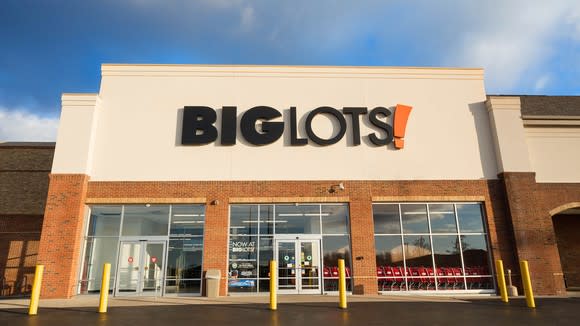3 Top Small-Cap Stocks to Buy Right Now
Small-cap stocks sometimes get a bad rap, labeled as risky alternatives to their larger brethren, but there are numerous reasons these younger businesses deserve a place in your overall investing strategy. Smaller companies have a much greater potential growth runway than their mid- and large-cap peers and are underrepresented among institutional investors and the major benchmarks. These under-the-radar opportunities can deliver balance to a portfolio, as well as providing a boost to returns. The problems lies in uncovering the best opportunities among these up-and-comers.
In an effort to help narrow the field, we asked three Motley Fool investors to identify three small-cap stocks that represent compelling opportunities. Here's why they chose Big Lots (NYSE: BIG), Extreme Networks (NASDAQ: EXTR), and Appian (NASDAQ: APPN).

Image source: Getty Images.
Everyone loves a bargain
Nicholas Rossolillo (Big Lots): Small-cap stocks have been the best performers on the market this year, and as a result, valuations for many of them are getting stretched pretty thin. Not all small companies are high-octane growth propositions, though; some are well-established value plays that could anchor a portfolio and provide dividend income.
Enter Big Lots, currently trading at 10.9 trailing price to earnings, 8.8 forward price to earnings, and yielding a 3% dividend. Shares are down 22% on the year, most of which came in March after the fiscal 2017 fourth-quarter report showed sales lower than what was expected. That trend of underperforming sales continued in the first quarter of 2018, with same-store comparables falling 3% from a year ago and adjusted earnings declining 21%.
Retail can be a volatile business, and Big Lots chalks most of these issues up to weather and lack of compelling inventory. Management reported that trends were reversing in the spring and that it expects second-quarter comparables to be flat to up 2% from the year before. As for inventory, the big-box discount chain has updated its offerings, especially in the important furniture department. Newly remodeled locations that feature a revamped brand and shopping experience are also reporting better sales than the old stores, providing hope that brick-and-mortar still has a place in the world of shopping.
That doesn't mean Big Lots is relying solely on its legacy storefronts. The chain was a latecomer to the digital world, bringing its revolving lineup of merchandise online just two years ago. Specific digital sales figures haven't been provided, except to say they were the best ever in the first quarter and the operating loss from the segment continues to narrow.

Image source: Big Lots.
Overall profitability is expected to rebound as the year progresses, and management has doubled down on its conviction that it can still grow. The quarterly dividend was increased by 20% back in March, and an accelerated purchase of $100 million worth of Big Lots shares was announced in June. That makes this small-cap look like a compelling value right now.
The app builder for non-tech people
Danny Vena (Appian): There's a continuing shortage of software developers in the U.S. that isn't expected to let up anytime soon, and finding qualified applicants to fill these positions is only getting more difficult. Companies looking to hire employees for these in-demand jobs could end up paying more than 20% above the going rate. This shortfall is increasingly leading companies to seek viable alternatives.
One company set to reap the rewards of this shortage is Appian, a leader in a corner of technology known as "low code." For the uninitiated, this allows those with no knowledge of software coding to develop and deploy software systems and apps quickly and easily. The company's software-as-a-solution (SaaS) model lets any potential customer with an internet connection make use of its tools.
The company utilizes a land and expand strategy -- once companies understand just how easy it is to use Appian's approach, they typically sign on for more. Its subscription revenue retention rate -- which measures revenue growth from existing customers -- typically exceeds 100%, and grew to 119% in the most recent quarter.

Image source: Getty Images.
Appian's revenue increased 33% year over year in 2017, and that growth is accelerating. For the first quarter of 2018, sales increased 35% compared to the prior-year quarter, driven by growth of its high-margin subscription revenue, which increased 36% year over year, and professional services revenue that jumped 46% compared to the year-ago quarter. It's important to note that as the company is still in the early phase of its growth story, it has yet to produce a profit.
Strong first-quarter results and a new seven-figure deal caused the company to raise its guidance -- it's now expecting revenue to increase between 30% and 31% this year, on top of last year's rapid growth.
The company is filling a vital need in a high-growth industry, which is why I believe Appian is a small cap to buy right now.
This enterprise networking specialist never looked better
Anders Bylund (Extreme Networks): After a decades-long history of focusing strictly on traditional Ethernet solutions, Extreme went on a buyout binge last year that transformed the company into a top-to-bottom provider of networking solutions for the modern data center. The company is still adjusting to its newfound heft and investors aren't quite sure what to make of it yet.
This could be the perfect time to start a position in the new and improved Extreme Networks.
The magnitude of Extreme's buyout-powered strategy shift caught the eye of investors in 2017, driving share prices sky high. At the end of January 2018, the stock could look back on a 52-week return of 174%.
But that was too much, too soon. The stock traded at a nosebleed-inducing 99 times adjusted earnings in January. Priced for absolute perfection, Mr. Market expected nothing but huge earnings surprises in the spring's earnings reports.

Image source: Getty Images.
That didn't happen. Extreme missed Wall Street's revenue targets in February and followed up with soft results across the board in May. Today, share prices have plunged 24% lower from January's multiyear highs. Now trading at 75 times trailing earnings, the stock still looks expensive but the pressure to deliver pitch-perfect results in every report is dramatically lower.
The company really is a legitimate challenger to Cisco Systems and Juniper Networks these days, and arguably the only full-range data center networking specialist outside of those two sector giants.
Looking ahead, Extreme Networks has guided to annual revenue growth in the 5% range, which is fully in line with Cisco's projections and ahead of Juniper's targets. This company is poised to steal market share from its larger rivals in the coming years, armed with a synergistic networking portfolio that neither Extreme itself or any of its acquisitions could boast on their own.
This is a winner in the long run, and Wall Street is starting to get it. Based on analysts' estimates, that massive P/E ratio falls to 8.7 times forward earnings.
More From The Motley Fool
Anders Bylund has no position in any of the stocks mentioned. Danny Vena owns shares of Appian. Nicholas Rossolillo owns shares of Appian. The Motley Fool owns shares of and recommends Appian. The Motley Fool has a disclosure policy.

 Yahoo Finance
Yahoo Finance 